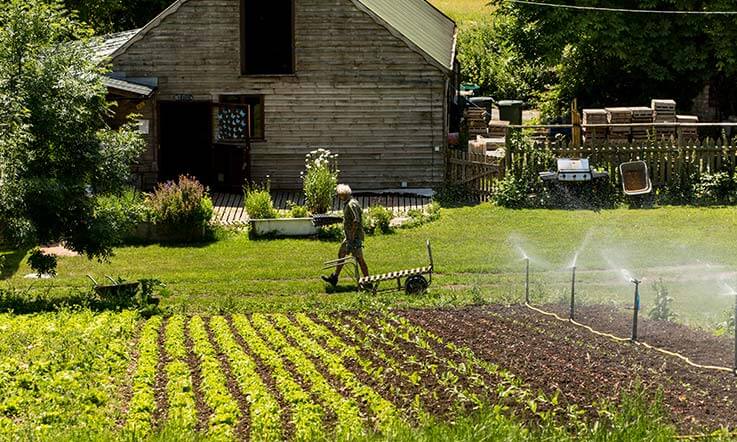The dairy industry stands at a crossroads. Farmers are aware of the delicate balance between productivity and environmental stewardship. One of the biggest challenges? Nitrogen is vital, yet its excessive application can lead to significant environmental impacts, from greenhouse gas emissions to water pollution.
That’s why the recent Open Farm Evening at Newcastle University on 4th June 2025 was such an important event, with Julia Cooper, Senior Researcher in Crop Diversity & Agronomy at ORC talking about the GreenGrass Project. This project focuses on grassland management, soil health and nutrient cycling to create more sustainable farming systems.

Julia’s expertise highlighted that reducing our reliance on synthetic nitrogen isn’t just an environmental imperative; it can be a smart business decision too. So, what practical steps can dairy farmers take right now to start making a difference?
Optimising manure management is a powerful way to cut down on bought-in nitrogen. Your farm’s slurry and farmyard manure are incredibly valuable resources, so don’t let their nitrogen content vanish into thin air! By using precision farming techniques like dribble bars or shallow injection, you can ensure manure is applied accurately and at the right time, exactly when crops need those nutrients. This approach minimises ammonia emissions and maximises nutrient uptake.
Equally important are your storage solutions. Covering slurry stores, for instance, can drastically reduce nitrogen losses. Less loss means more available nutrients for your crops, which directly translates to less bought-in fertiliser. On top of that, regular analysis of your manure is key. Knowing its exact nutrient content allows for more precise application, helping you avoid over-fertilisation and wasting valuable nitrogen.
Beyond manure, think about tailored grazing strategies. Strategic grazing can help cycle nutrients more effectively within your pastures. Practices like rotational grazing ensure an even distribution of manure and minimise nutrient ‘hotspots’ where excess nitrogen might be lost.
And we should not forget the crucial role of legumes in swards and rotations to capture free N from the atmosphere and turn it into plant nitrogen. Clover and other legumes are nature’s nitrogen factories, naturally fixing atmospheric nitrogen into the soil. Integrating them into your grasslands through multi-species swards can significantly reduce the need for purchased nitrogen. Consider overseeding existing pastures or incorporating clover into new leys. This agroecological approach not only provides a natural nitrogen source but also fosters a healthier soil microbiome, improving nutrient availability naturally.
Plant biostimulants are a potentially exciting avenue for improving grass performance without relying on nitrogen inputs and a big part of the GreenGrass project work this year. Independent of their nutrient content, biostimulants purport to improve nutrient use efficiency, stress tolerance, quality traits and soil nutrient availability in plants or the rhizosphere. However, there is a need for research to cut through the noise around biostimulant usage and pinpoint where they might best be used in farming systems.
Ultimately, focusing on soil health underpins all these efforts. A healthy, biologically active soil is far more efficient at retaining and cycling nitrogen. Practices that build soil organic matter, such as reduced tillage and diverse crop rotations, significantly improve overall nitrogen use efficiency on your farm.
Catriona Willoughby and Julia Cooper’s work on the GreenGrass project, offers exciting avenues. GreenGrass is actively exploring novel strategies to reduce N fertiliser use on grasslands while maintaining productivity and profits in dairy systems.
You can find out more about the project by watching the Project Launch Webinar led by Julia Cooper with panel members James Standen (Newcastle University), Elaine Jewkes (SoilSense), Paul Muto (North Pennines National Landscape) and Alma Joensen (Car Y Mor).
The webinar looks at new technologies like slurry inoculants, nitrification inhibitors, foliar N products, and biostimulants.
ORC is commitment to participatory action research means we are working directly with farmers, co-creating solutions that are both scientifically sound and practically applicable. This collaborative approach is vital for accelerating the transition to more sustainable dairy farming.
Are you a dairy farmer who’s already exploring ways to cut down on nitrogen fertiliser? Or perhaps you’re keen to learn more about the project and how you can move towards lower-input dairy farming?
We are actively looking to network and speak to other dairy farmers who are focused on reducing nitrogen fertiliser use. Your experiences, challenges, and successes are invaluable to our research. We believe that by sharing knowledge and collaborating, we can collectively build a more resilient and environmentally responsible dairy sector.
Please get in touch with us via this form, your ideas could really help.
